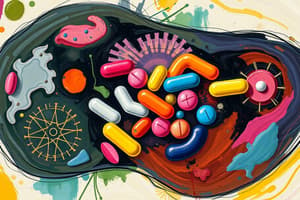Podcast
Questions and Answers
What is the effect of bile acid binding resins on HDL levels?
What is the effect of bile acid binding resins on HDL levels?
- It increases HDL levels
- It increases TGs levels
- It has no effect on HDL levels (correct)
- It decreases HDL levels
What is an adverse effect of bile acid binding resins?
What is an adverse effect of bile acid binding resins?
- Constipation (correct)
- Increased appetite
- Weight loss
- Muscle pain
What is the mechanism of action of ezetimibe?
What is the mechanism of action of ezetimibe?
- Inhibiting NPC1L1 in the brush border of enterocytes (correct)
- Decreasing bile acid production
- Inhibiting HMG-CoA reductase
- Increasing liver cholesterol synthesis
What is the effect of ezetimibe on fat-soluble vitamins?
What is the effect of ezetimibe on fat-soluble vitamins?
What is the clinical use of statins?
What is the clinical use of statins?
What is the mechanism of action of statins?
What is the mechanism of action of statins?
What is the effect of bile acid binding resins on TGs?
What is the effect of bile acid binding resins on TGs?
When should other medications be taken in relation to bile acid binding resins?
When should other medications be taken in relation to bile acid binding resins?
What is a contraindication for bile acid binding resins?
What is a contraindication for bile acid binding resins?
What is the purpose of combining ezetimibe with statin treatment?
What is the purpose of combining ezetimibe with statin treatment?
Flashcards are hidden until you start studying
Study Notes
Statins
- Combinations with other classes of lipid-lowering drugs have recorded favourable outcomes.
- Kinetics: Atorvastatin and rosuvastatin are considered most potent, while fluvastatin is the least potent.
- Long-acting statins include pravastatin, atorvastatin (half-life approx. 14 h), and rosuvastatin.
- Lovastatin and simvastatin (half-life 3 h) are relatively short-acting.
Adverse Effects of Statins
- Statins are generally well-tolerated, but mild unwanted effects include GI disturbance, increased liver enzymes in plasma, insomnia, and rash.
- Serious but rare effects include muscle disturbances, such as muscle pain, myositis, and rhabdomyolysis (CoQ involvement), and acute kidney injury (mainly due to myoglobin filtration).
Drug/Food Interactions with Statins
- Grapefruit juice, erythromycin, ritonavir (and other enzyme inhibitors), red yeast rice, alcohol, and other lipid-lowering drugs (e.g., niacin) can interact with statins.
Fibrates (Fibric Acid Derivatives)
- Examples include bezafibrate, fenofibrate, gemfibrozil, and clofibrate.
- Fibrates cause a marked decrease in circulating VLDL, leading to decreased TG levels.
- They also moderately reduce LDL and moderately increase HDL.
Mechanism of Action of Fibrates
- Fibrates are agonists at the peroxisome proliferator-activated receptor α (PPARα), a nuclear receptor.
- They increase transcription of genes for lipoprotein lipase, apoA1, and apoA5, leading to the hydrolysis of TG in chylomicrons and VLDL particles.
- Fibrates also increase hepatic LDL uptake, diminishing chylomicron, IDL, and cholesterol-rich VLDL (βVLDL) clearance.
Secondary Dyslipidemia
- Occurs secondary to factors such as age and gender (menopause, old age), lifestyle (excessive alcohol intake, smoking), disease (e.g., hypothyroidism, type II diabetes, CKD), and drugs (steroids, oral contraceptives, thiazide diuretics).
Therapeutic Options
- Inhibitors of cholesterol absorption (bile acid resins and ezetimibe)
- Statins (HMG-CoA reductase inhibitors)
- Fibrates
- Nicotinic acid or its derivatives
- Others (fish oil derivatives, probucol)
Bile Acid Binding Resins
- Cholestyramine, colesevelam, and colestipol are cationic polymer resins that bind non-covalently to negatively charged bile acids in the intestine.
- The non-absorbable resin-bile acid complex is excreted in stool.
Enterohepatic Recirculation
- Most bile constituents are eliminated in feces, but bile salts are reclaimed by the enterohepatic circulation, which absorbs and returns bile salts to the liver.
Bile Acid Binding Resins: Actions and Effects
- Increase 7α-hydroxylase activity, catalyzing cholesterol → bile acid conversion
- Hepatic cholesterol markedly reduces, leading to upregulation of LDL receptors and enhanced clearance
- Reduces LDL-C (28%), but causes an unwanted increase in TGs
- Unwanted effects include constipation, diarrhea, bloating, and dyspepsia
Ezetimibe
- Inhibits duodenal cholesterol absorption by blocking NPC1L1 in the brush border of enterocytes
- Reduces intestinal cholesterol absorption by about 50%
- Effective in combination with statins in the treatment of hypercholesterolaemia
- Absorption of fat-soluble vitamins, TGs, or bile acids is not affected
Studying That Suits You
Use AI to generate personalized quizzes and flashcards to suit your learning preferences.


